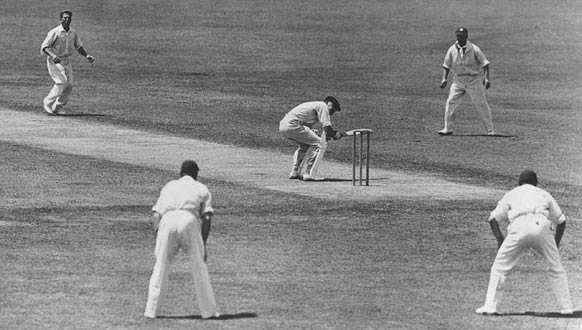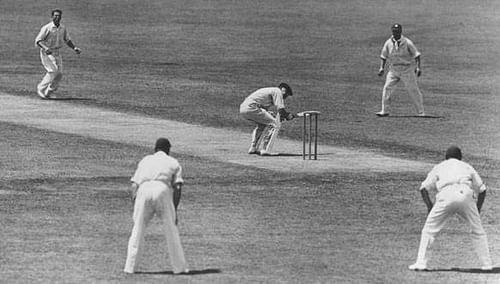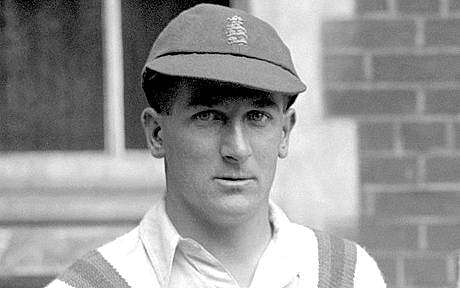
A look back at the historic Bodyline series

In the days and months following Australian cricketer Phil Hughes’s untimely demise from being hit by a bouncer, fast bowlers across the world had been reluctant to use the short ball. However, the World Cup this year stood witness to some quality short-pitched bowling testing the mettle of the batsmen at every step. A potent weapon in the bowler’s armour, bouncers tilt the scales in the bowler’s favour in a sport that otherwise seems to favour the batting side so much.
Nonetheless, after the introduction of the bouncer rule in the early 1990s, bowlers have become more astute in their use of the short ball. The rule restricts them from bowling more than two bouncers in an over; only one bouncer per over per batsman. Although it was on an experimental basis in 1991, it entered the rule book in 1994 in its current form:
1. a bowler shall be limited to two fast short-pitched deliveries per over; b) a fast short-pitched delivery is defined as a ball which passes or would have passed above the shoulder height of the striker standing upright at the popping crease; c) the umpire at the bowler's end shall advise the bowler and the batsman on strike when each fast short-pitched delivery has been bowled; d) …a ball that passes above head height of the batsman, that prevents him from being able to hit it with his bat by means of a normal cricket stroke shall be called a wide; e) For the avoidance of doubt any fast short-pitched delivery that is called a wide under this playing condition shall also count as one of the allowable short pitched deliveries in that over.
Before this law was in effect, fast bowlers across teams hunted in packs taking apart opposition batters with well-directed bouncers. The West Indies pace quartet of the early 1980s stood out from the rest as their express pace and bounce proved to be an Achilles heel for many batsmen of that time. The sustained use of bouncers during those days did draw a lot of flak as many considered it to be against the spirit of the game and unwanted even but that did not buck the trend.
So much talk about short-pitched bowling and its perils reminds me of a sporting event dating back to the early 1930s that caused quite a political stir back then precisely because of its overt use of what we today call – the bouncers. The Ashes series played in 1932/33, at its lowest point, threatened the game itself putting political relations between England and Australia in jeopardy. Although the tour ended without any serious incident, it did leave an indelible impact on the minds of a generation of cricketers and fans alike.
The Bodyline series
Infamously known as the Bodyline series, the tour invoked a previously unspoken element of the game – physical intimidation of the batsmen. Bodyline was a tactic hatched by the then England captain, Douglas Jardine, and his premier fast bowler, Harold Larwood, to negate the genius of Australian legend Sir Donald Bradman.
Bradman had previously frightened the England side by amassing 974 runs in the five Tests that he played against them in 1931. Jardine knew that the only way they could stop Australia was by getting rid of Bradman in one way or the other. The legend goes that in 1931, some players watched Bradman cringe when hit on the body and that motivated Jardine to work out a plan around Larwood, Bill Voce, Bill Bowes and Gubby Allen, who were all extremely efficient and seriously quick bowlers, to trap their number one nemesis.
The strategy
The strategy itself wasn’t very complicated. With no restriction on the number of fielders one could have on the leg side, Jardine asked his bowlers to stick to a leg-stump line and aim for the ribs and throat of the batsmen with fielders placed in every single catching position possible. That constrained the batsmen since they now had to manoeuvre the ball past a packed leg-side field if they wanted to score runs.
Also known as fast leg theory, Jardine’s trump card for the plan was Larwood, undoubtedly the quickest bowler at his disposal. The theory on paper looked sound but it required a perfect execution on the field. As is the case with short-pitched bowling, it is most effective when delivered with the right blend of pace and direction.
A rudderless barrage of bouncers can only do more harm than good to a bowling side. Out of all the bowlers that Jardine had on that tour, Larwood was the only one capable of bowling consistently at a rapid pace at the body of the batsmen. His ability to make the ball rise from just back of a length on those unresponsive Australian pitches of the time was really commendable and helped Jardine get on with the plan without much fuss.
Larwood was one of the fastest bowlers of the time

A fast bowler from the mines of Nottingham, Larwood stood for what fast bowlers are meant to stand for – shock and awe. Duncan Hamilton, Larwood’s biographer, said: “He had two things. Firstly, he was incredibly accurate, he claimed never to have bowled a wide in his career, and accuracy was essential to Bodyline. Secondly, he was devastatingly fast. All his contemporaries said he was the quickest they had faced. At certain times, during that series, he must have got close to, if not passed, the 100 mp/h (160kmp/h) mark.”
It doesn’t come across as a surprise then that having dismissed Bradman 4 times in that series, he did prove to be the right person for the action-filled plan and executed his captain’s orders flawlessly. He picked 33 wickets in that series, 16 of which were bowled suggesting that only a little over 50% of his victims fell to the actual bodyline tactic. These figures stand a testimony to the fact that while he spread terror in the opposition with his leg-side line, he was equally adept at dismissing batsmen by bowling more conventional line and length.
The actual series
Now that we have a brief idea about what unfolded in the due course of that acrimonious Ashes series, let us take a sneak-peek into what really happened during the series.
The tour began at Sydney in December 1932 ironically without Bradman who wasn’t playing; reasons for which are nebulous to date. Some say it was due to illness while others claim that it was a row with his own board that kept him out of that match. England won that Test without employing their Bodyline tactic, although there were complaints regarding excessive use of short-pitched bowling by England pacers. The Test became memorable for Australian batsman Stan McCabe’s courageous 187 and Larwood’s 10-wicket haul.
The series moved to Melbourne where Bradman made a comeback but got out for a duck in the first innings; however he came back strongly with an unbeaten 103 in the second innings and took Australia to victory. Even so, the pressure was mounting on Australia as the bruises and wickets kept piling but the storm was yet to hit.
The series was levelled at 1-1.
A simmering pot came to its boil in the city of churches, Adelaide. With the series at stake, Jardine and Larwood used the Bodyline tactic at full tilt. Things started spinning out of control when Larwood struck Australian captain Bill Woodfull on his chest and then Bert Oldfield with a vicious bouncer fracturing his skull. Interestingly enough, neither of the injuries occurred when Larwood was employing the Bodyline tactic and yet, the entire match was filled with instances where Jardine urged his bowlers to bowl a hostile line to every Australian batsman who walked out to bat.
During the day and age when protection to a batsman was limited to just a box, such tactics took menacing proportions threatening the lives of the players. England went on to win that Test match and consequently the series 4-1.
The Bodyline series had finally ended and English cricket savoured their most cherished victory over arch-rivals Australia.
Observations
Bradman endured his least successful Test summer that year as he managed to score just one century in the eight innings that he played and was dismissed thrice between scores of 50-100. His average for that series was just 56.57; the worst over the course of his career.
Despite the hostile tactics by England, what’s really praiseworthy is that Australia managed to put up reputable scores of 360, 228, 340 and 435 on the board every single time they batted first in that series. The numbers give you an idea of how good Woodfull’s Australian side was.
Unfortunately, meanwhile, Larwood, who was the chief architect of England’s victory, never played a Test match after that. In his short Test career, Larwood played a total of 21 matches, picked 78 wickets (33 of which came during the Bodyline series) with an economy rate of 2.67 and had three- 5-wicket hauls and one 10-wicket haul to his name.
Consequences
When the heads were rolled and the debates had settled, the political ramifications of the series were quite far-reaching but we will focus on cricketing consequences here. Soon after the series ended, rules were tweaked and having unlimited fielders near the batsman was deemed illegal.
It’s been a little more than eight decades since that series and critics to date are arguing if England were right in doing what they did. Jonathan Agnew, BBC cricket correspondent, points out that the Australian administrators who made such a fuss of Jardine’s tactics in that series didn’t raise a voice when their own fast bowlers Dennis Lillee and Jeff Thomson were petrifying batsmen with their short-pitched bowling in the 1970s.
He is quick to add that fast bowling, even today, is every bit as intimidating even after the introduction of new rules and safety equipments for the batsmen. That Jardine and his men used bodyline to intimidate and not to restrict was one of the chief concerns of the administrators at that time and rightly so.
The Bodyline series was monumental in the annals of cricket history for two reasons: firstly, it delineated the thin line between gamesmanship and unfair play and secondly, showed us the absolute power of the game of cricket and the sport shall remain indebted to Jardine, Larwood and Woodfull for that.